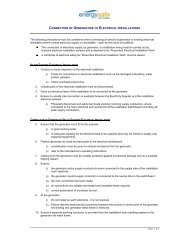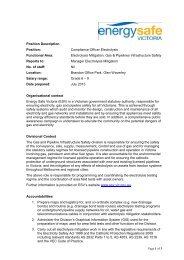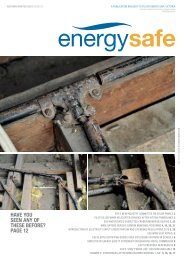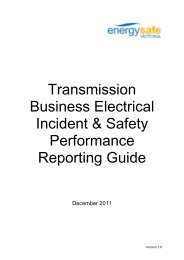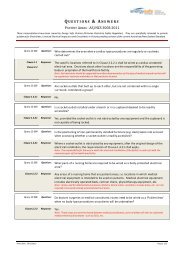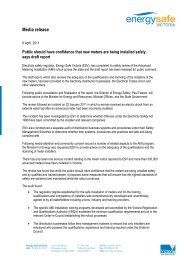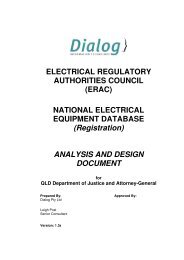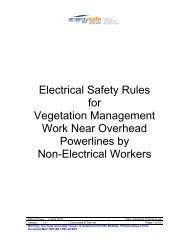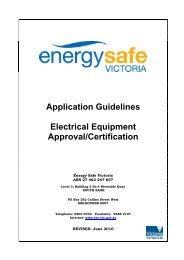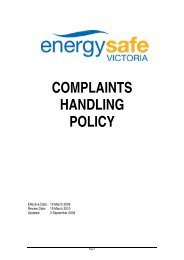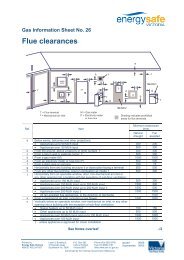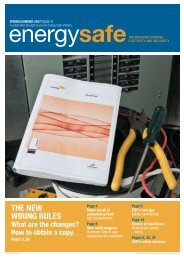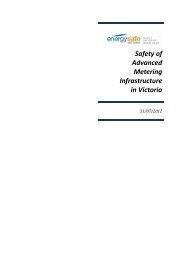as/nz wiring rules 3000:2007 (PDF) - Energy Safe Victoria
as/nz wiring rules 3000:2007 (PDF) - Energy Safe Victoria
as/nz wiring rules 3000:2007 (PDF) - Energy Safe Victoria
You also want an ePaper? Increase the reach of your titles
YUMPU automatically turns print PDFs into web optimized ePapers that Google loves.
electricityQsand AsQ. Is a refrigeration mechanic with a D licence permitted to install240v interconnect cables for split system air conditioners? Someunits are direct wired through an isolator and some units plug into <strong>as</strong>ocket outlet. Under what circumstances if any are the interconnectcables regarded <strong>as</strong> part of the appliance and able to be installed bya competent person?A. The installation of interconnect cables that are 240 volts is deemedto be electrical installation work under the Section 3 definitions in theElectricity <strong>Safe</strong>ty Act 1999, and is therefore not within the scope of aD licence holder. The person undertaking this work needs to be anA cl<strong>as</strong>s (formerly E licence) holder.Q. If I have installed a cover over my extra low voltage (ELV) downlightscan the distance be decre<strong>as</strong>ed from those that are shown in Figure4.7 of AS/NZS <strong>3000</strong>:<strong>2007</strong>?A. The requirements are outlined in Clause 4.5.2.3, which states:“4.5.2.3 Recessed luminairesRecessed luminaires and their auxiliary equipment shall be installed ina manner designed to minimise temperature rise and prevent the riskof fire. The temperature rise at the rear of a recessed luminaire shall belimited to prevent damage to adjacent materials.This requirement shall be satisfied by one of the following methods:(a) The use of a luminaire specifically designed and certified by themanufacturer to permit—(i) contact with combustible materials; or(ii) enclosure or covering by thermal insulation material, <strong>as</strong>appropriate to the location of the luminaire.(b) Installation of the luminaire within a suitable fire-resistant enclosure.(c) Provision of required clearances from combustible and thermalinsulating material <strong>as</strong> specified by the manufacturer of the luminaire.(d) Provision of the default clearances from combustible and thermalinsulating material <strong>as</strong> specified in Figure 4.7.Where manufacturer’s installation instructions that specify requiredclearances are not available, the luminaire shall be installed in accordancewith (b) or (d).NOTE: In the c<strong>as</strong>e of a suitably designed luminaire, the installation instructions may specify thatno clearance is required.Recessed luminaires and their auxiliary equipment shall be installed insuch a manner that necessary cooling air movement through or aroundthe luminaire is not impaired by thermal insulation or other material.Where thermal insulation is of a type that is not fixed in position, e.g.loose fill, a barrier or guard constructed of fire-resistant material shall beprovided and secured in position to maintain the necessary clearance(see Figure 4.7).”Therefore if there are no other me<strong>as</strong>urements stated with themanufacturer’s instruction then (b) and (d) are to be applied. With no otherinformation the default me<strong>as</strong>urements of Figure 4.7 are to be adhered to.Q.On a large site that is multiple occupancy where does the prescribedelectrical work end? Do I require more than one prescribed certificateof electrical safety?A.In the Electricity <strong>Safe</strong>ty (Installation) Regulations 1999 the requirementsof prescribed electrical installation work are outlined in Regulation 406.When seeking to identify the parts of the electrical installation work thatare prescribed electrical work Regulation 406 (a) and (b) provide theanswer by stating:“406. Prescribed electrical installation work(1) For the purposes of section 45 of the Act, “prescribed electricalinstallation work” means work on all or part of any of the followingelectrical installations if they are ordinarily operated at low voltage ora voltage exceeding low voltage—(a) consumers mains, main earthing systems, consumers terminalsconnection devices and those parts of main switchboards thatare related to the control of installations and the protectionagainst the spread of fire;(b) sub-mains, earthing systems and any distribution boardsrelated to the control of individual occupiers’ portions of multipleinstallations unless the occupier h<strong>as</strong> immediate and unimpededaccess to the main switch or switches controlling the whole ofthe multiple installation.”It is important to understand that Regulation 406(b) details therequirements for the distribution boards related to the control of theindividual occupiers portions of the installation. This means that theperson who owns the individual occupancy needs to be able to haveunimpeded access to the main switch or switches or otherwise theprescribed electrical work continues to the switch that the individualoccupier does control. This is usually the isolating switch contained inthe switchboard in their unit/apartment or townhouse, so this is wherethe prescribed electrical work ends.With respect to the number of prescribed certificates of electrical safetythat are issued, then the Electricity <strong>Safe</strong>ty (Installation) Regulations1998 provides the answer in Regulation 410(3) which in Part (c) requiresthe address and postcode of the electrical installation. Therefore if theelectrical installation address is Unit 3012, XYZ Towers, Melbourne,it would be understood that each unit would require its own prescribedcertificate of electrical safety, to accurately record the electrical installationwork performed at that address.25SUMMER/AUTUMN 2008 ISSUE 11esv reminder on IP 23 light fittingsFor many years there have been IP 23rated light fittings available for useon electrical installations and manyregistered electrical contractorsand electrical workers have soughtto use them.ESV recently received complaints from somecustomers about these light fittings andtherefore reminds RECs and LEIWs of thefollowing.When installing any fitting or equipment inan area that requires a degree of IP rating,the installer must meet the fundamentalrequirements in AS/NZS <strong>3000</strong>:<strong>2007</strong>. Clause1.7 details the requirements for the selectionand installation of electrical equipment andcovers the essential fundamentals, installationwork practice, equipment selection and dampsituations.The fittings that have been bought to theattention of ESV are a PVC composition and area batten holder style. The fitting itself is IP ratedand when the consumer inserts a standardglobe they are finding out that the globe failswhen it rains due to the heat of the globe.These fittings have been installed on the outsideof the buildings and used in place of a spotlightor other fitting. Customers experienced theproblems during heavy rain experienced onocc<strong>as</strong>ions recently.ESV urges RECs and LEIWs who install thesetype of fittings on the outside of buildings toreconsider this method and instead adoptthe requirement of Clause 1.6 of AS/NZS<strong>3000</strong>:<strong>2007</strong>, which covers the design of theelectrical installation, and ensure that any lightfitting installed on the outside of buildingsfunctions correctly <strong>as</strong> intended.



